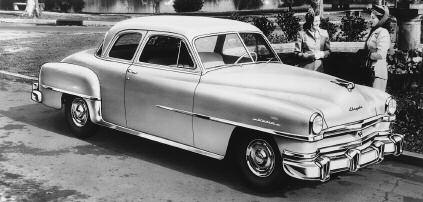Chrysler Corp. history
Traditionally the third-largest American manufacturer of automobiles, behind GENERAL MOTORS and Ford. The company traces its origins to the Maxwell-Briscoe Co., formed by Jonathan Maxwell and Benjamin Briscoe in 1903 in Tarrytown, New York. The first car produced by the company was the Maxwell. In 1910, the United States Motor Car Co. was formed, consolidating several smaller manufacturers, including Maxwell, although the company failed three years later. The company was then bought by Walter Flanders, who renamed it the Maxwell Motor Co. in order to capitalize on its most popular car and brand name.
But the new reorganization did not ensure the company success. By 1920, it had fallen into financial difficulties again, and Walter CHRYSLER, the retired president of Buick and a vice president of General Motors, was tapped to form a reorganization committee. As a result, the Chrysler Corp. was formed in 1921. The company continued to produce the Maxwell and also introduced the six-cylinder Chrysler Six in 1924, which became very popular in its own right. In 1926, the company announced a luxury model, the Imperial. Two years later, it began production of the Plymouth and the DeSoto. In 1928, it also made one of its largest acquisitions to date.
Chrysler was approached by Clarence Dillon of the Wall Street firm DILLON READ & CO. The manufacturer had been owned by Dillon for several years after he bought it from the Dodge family following the untimely deaths of the Dodge brothers who had guided the company. He offered to sell it to Chrysler. The purchase price was $170 million, and Dodge became a division of Chrysler, adding to its product line. In the 1930s, the company announced new designs for its cars, including the Airflow concept, which changed cars from boxy carriages to more modern, flowing styles. Most vehicle production was devoted to the war effort in the early 1940s, but the company began introducing rapid style changes to its lines in the 1950s and 1960s.

The company began to run into financial difficulties in the late 1970s. In 1979, Lee IACOCCA, a former Ford executive, was named chairman, and in the following year, the company had to be bailed out by a federal loan, one of the few ever made to the private sector. The federal government loaned Chrysler $1.5 billion under the Loan Guarantee Act. Chrysler also sold its defense division to General Dynamics. The restructuring was successful, and the company was able to repay the loan in 1983. The early 1980s were considered the turning point for the company, which was able to survive its financial difficulties.
In 1984, the first minivan was introduced, and the vehicle became one of the most important product lines in the company’s history. A year later, the company entered an agreement with Mitsubishi Motors of Japan to jointly build subcompact cars in the United States. Later in the 1980s, it established a seven-year/70,000- mile power train warranty for its cars and in 1987 completed a takeover of American Motors, absorbing the country’s fourth-largest car manufacturer. The deal allowed it to acquire the Jeep line of vehicles. In 1988, the company introduced the first passenger vehicle equipped with a standard driver-side airbag.
By the 1990s, the company again was highly profitable. A prolonged takeover fight with investor Kirk Kerkorian in the 1990s shook the company and eventually caused it to seek a merger partner. Finally, in 1998 it merged with Daimler Benz of Germany in what was described as a “merger of equals.” Ultimate management control of Chrysler moved to Germany as a result. The company remained the number three domestic automaker behind General Motors and Ford, although it was classified as a foreignowned corporation.
Further reading
- Hyde, Charles K. Riding the Roller Coaster: A History of the Chrysler Corporation. Detroit: Wayne State University Press, 2003.
- Langworth, Richard, and Jan Norbye. The Complete History of Chrysler Corp. 1925–1985. New York: Beekman Publishers, 1985.
- Moritz, Michael. Going for Broke: The Chrysler Story. Garden City, N.Y.: Doubleday, 1981.
- Reich, Robert B., and John Donahue. New Deals: The Chrysler Revival and the American System. New York: Times Books, 1985.